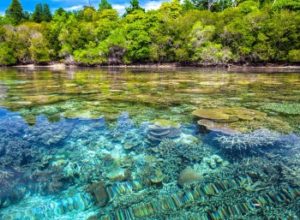by P. Gosselin, Mar 8, 2023 in WUWT
IPCC high-end sea level predictions for 2100 are “highly erroneous”.
Global warming alarmists like to claim that Pacific island nations are on the verge of disappearing – due to rising sea levels caused by polar ice melting due to global warming, which in turn supposedly is caused by rising concentrations of “heat-trapping” trace gas CO2 from the burning of fossil fuels.
These coral reef island nations risk going under real soon, unless we wean ourselves from fossil fuels soon, they say.
Coral reef island nations are emerging, not disappearing
But yesterday Kenneth here presented a new paper appearing in Nature, (Kench et al., 2023), which looks at whether the coral reef islands are in fact seeing unprecedented and undergoing accelerating physical changes that risk outrunning human adaptation measures. The authors analyzed the dynamics of a Maldivian reef island at millennial to decadal timescales.
Recent changes not unprecedented
The researchers found that “island change over the past half-century (±40 m movement) is not unprecedented compared with paleo-dynamic evidence”.
Nothing unusual is happening. The global data suggest that almost all islands are in fact growing, and not disappearing under water like climate alarmists mistakenly believe.
“Recent shoreline changes (±40 m/50 years) are ‘dwarfed’ by the shoreline changes (±200 m/100 years) that occurred throughout previous centuries,” the study’s authors write.
89% of all the globe’s islands are stable, or growing!
Moreover, just 4 years ago, another peer-reviewed publication appearing in a renowned journal found similar results: 89% of the globe’s islands and 100% of large islands have stable or growing coasts! According to Duvat, 2019:
“88.6% of islands were either stable or increased in area, while only 11.4% contracted. It is noteworthy that no island larger than 10 ha decreased in size. These results show that atoll and island areal stability is a global trend, whatever the rate of sea-level rise.”
Moreover, Khan et al (2018) found: “Prediction of 4–6.6 ft sea level rise in the next 91 years between 2009 and 2100 is highly erroneous.”







